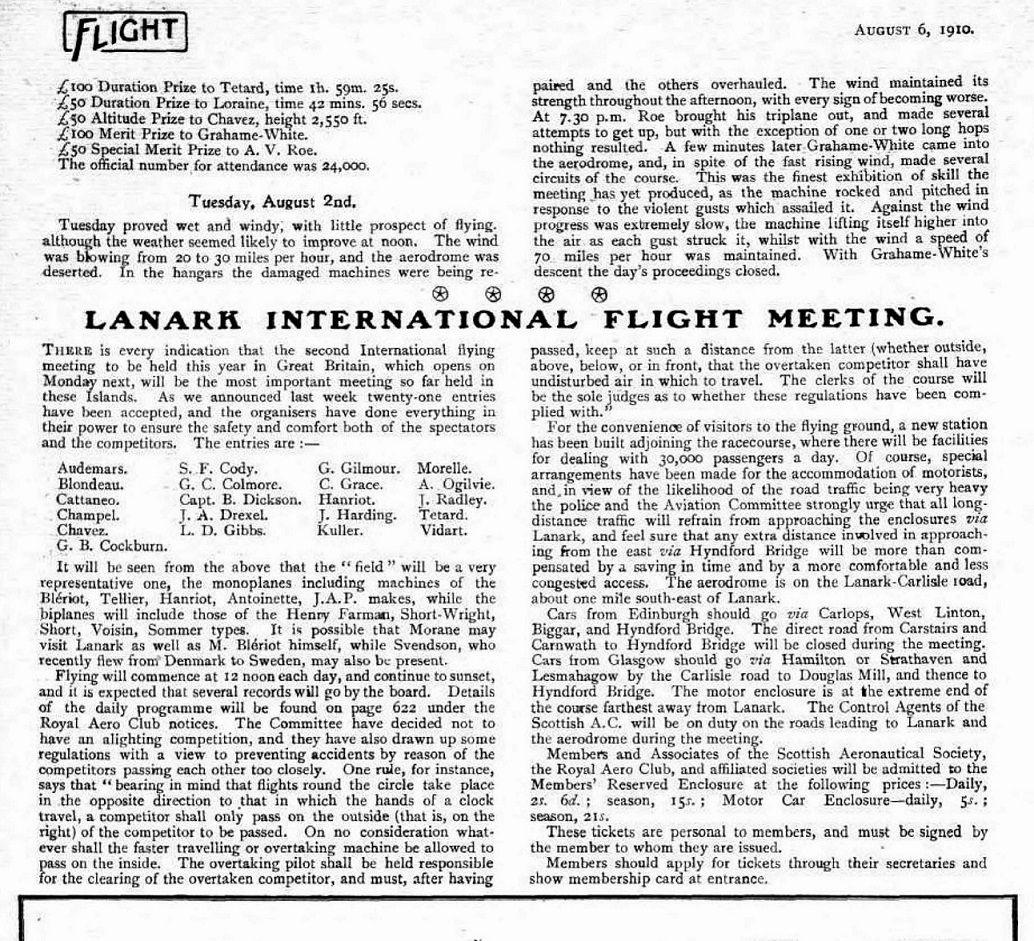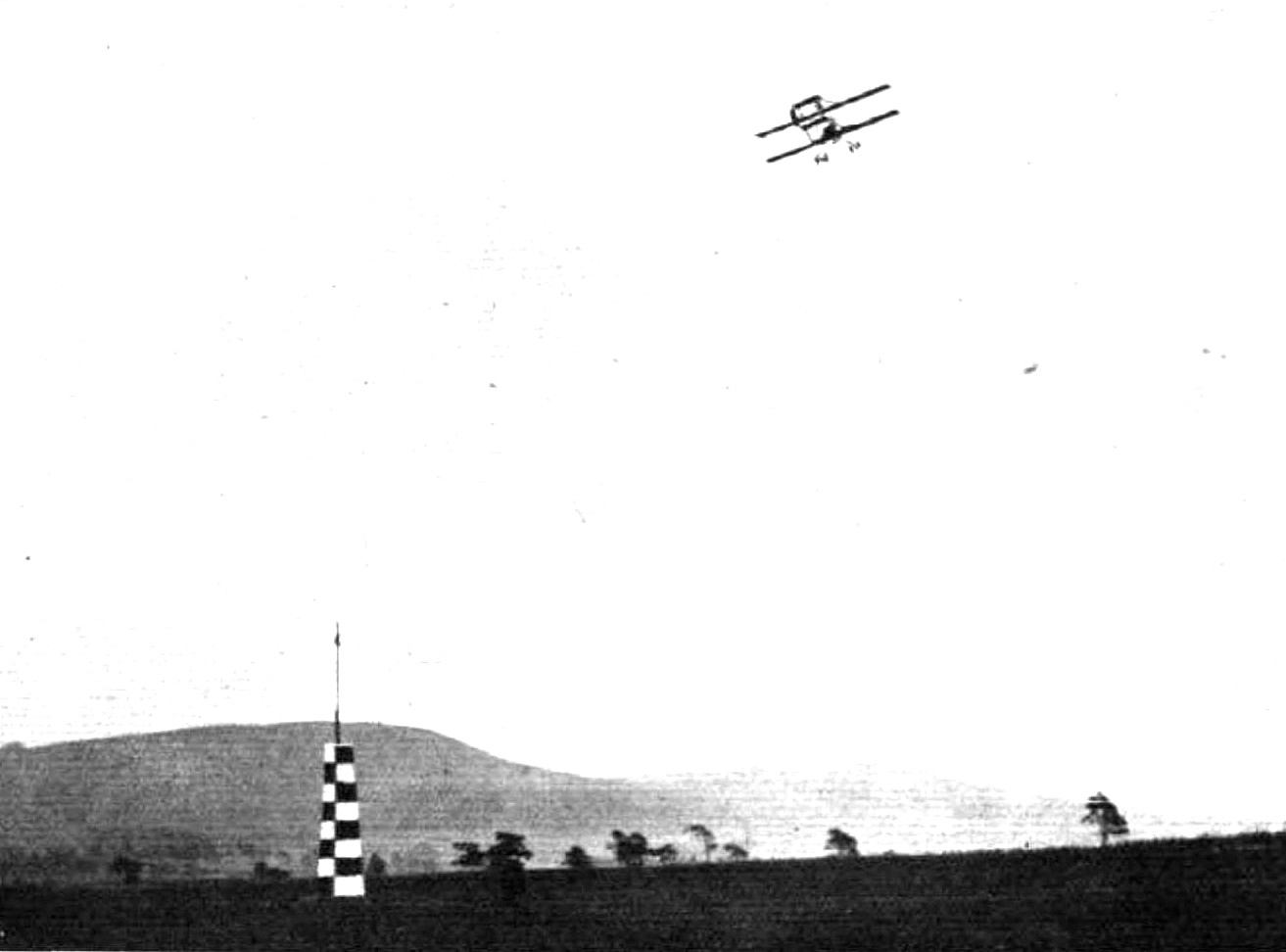Lanark
Note: This map is pretty much a guess as to the location. There is a lot of information on the web regarding this venue, but some of the maps are thirty or more miles (50km) astray. If anybody could kindly confirm if this map is correct, or offer a more exact location, this advice will be most welcome.
LANARK see also WESTBANK FARM
LANARK: Early flying display and aerial competition ‘temporary’ aerodrome, soon after to become a permanent aerodrome?
Flying school: Run by Mr William H Ewen 1910 to 1912 only? (Operated one aeroplane)
Manufacturing: W H Ewen (later based in Alloa CLACKMANNANSHIRE)
Location: Lanark racecourse (The racecourse closed in 1977)
Period of operation: August 1910 to 1912
NOTES: Lanark was Scotland’s first aviation meeting held on the 6th to 13th August 1910 arranged by the Scottish Aeronautical Society. The Caledonian Railway built a new station at Lanark racecourse to cope with the number of people expected to attend. Special trains were run and, a new development, car parks were put in place, and nearly 1300 of these new fangled contraptions (cars) arrived.
It is reported that over 200,000 spectators attended this event and more flying was done, (without injury – but with several “smashes”), than at any meeting since the fabulous Reims Meeting in 1909. Many flyers came up from the BLACKPOOL Meeting, (not flying up of course but transporting their 'machines' by rail and road), before returning to the BLACKPOOL Meeting. The first major "Aviation Meeting" at BLACKPOOL was held the year before from the 18th to 23rd of October 1909.
THE ENTRANTS
There were twenty two entrants at LANARK, exactly half of which were British: G A Barnes, G B Cockburn, S F Cody, G C Colmore, B Dickson, L Gibbs, D G Gilmour, C Grace, W E McArdle, A Olgivie and J Radley.
The foreign contingent, mostly French being: Audemars, Blondeau, Cattaneo, Champel, G Chavez, A Drexel, Edmond, Hanriot, Kuller, Tétard and Vidart.
Is there a reason known for foreign pilots to be mainly known by their surname only whereas British pilots had their initials included?
THE FIRST ACCURATE MEASURING DEVICES?
It was here that accurate apparatus was first used to measure aircraft speeds whilst airborne, a new competition being introduced to measure the fastest speeds over both a mile and, I think rather interesting and probably in deference to the number of French pilots attending (?), a kilometre. The fastest aircraft being a Blériot flown by James Radley at 77.67 mph. The American airman Mr A Drexel set a new altitude record too, at 6,750ft above the aerodrome, on the 12th August which, it should be pointed out is at 700ft above sea level to start with. I wonder when it was that all altitude records were calculated at AMSL (Above Mean Sea Level) or if the old records were later adjusted?
OTHER REPORTS
It is reported that George Cyril Colmore, (later Flight Commander in the airship section of the RNAS), crashed his Short biplane during this event into trees on take-off. Apparently without being seriously hurt! It also appears that Captain Bertram Dickson flew the first passenger in Scotland, a journalist, using his Farman biplane - at the 1910 meeting perhaps? Captain Dickson, who visited the Grand Semaine d’Aviation de la Champagne held near Reims in 1909 and was much impressed by what he saw and in May 1910 gained his Pilot Certificate No.71 from the Aero Club de France.
BECOMING AN AGENT
In 1911 W H Ewen became the sole Scottish agent for Deperdussin and in August 1911 used an example of the type to make an historic flight across the Firth of Forth, see PORTOBELLO (LOTHIAN)
A PERMANENT AERODROME?
This is a good example here of what might later constitute a ‘permanent’ aerodrome resulting from a major aviation event. Even though W H Ewen only had one aircraft based here, trading as W H Ewen Aviation Ltd in 1912 he held the sole rights to build and supply Caudron aircraft from that famous French manufacturer. It seems a tad uncertain where W.H.Ewen were building and supplying amphibian seaplanes, (Caudron G.2, G.3 and G.4 types), to the RNAS before moving to HENDON in January 1913 but I suspect it was likely most if not all of these were actually built at HENDON? Even so it seems likely some initial Caudron production started in or near LANARK and possibly on/near the racecourse?
A MICHAEL T HOLDER GALLERY
NOTES: Mike Holder is a great friend of this 'Guide' and has really done a great job for us here.
We'd love to hear from you, so please scroll down to leave a comment!
Leave a comment ...
Copyright (c) UK Airfield Guide



























